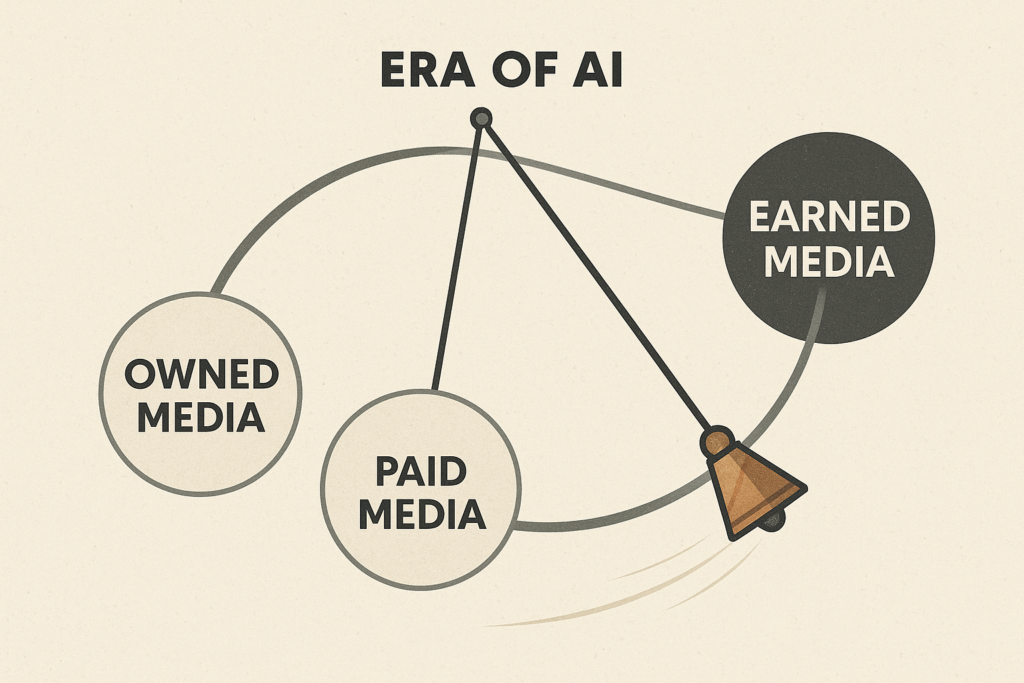
For the past decade, every startup and growth-stage tech company has tried to become a media company. The strategy? Go direct, don’t worry about earned media. Invest in content marketing. Own the channels. And champion inbound marketing as the ultimate growth strategy.
It worked. Startups ranked high in search results, driving inbound traffic and fueling both top and bottom-of-funnel demand. Some created truly insightful content that educated their markets. Others played the SEO game: stuffing keywords to climb rankings, regardless of the content’s value.
At BMV, we’ve always believed in the power of content, especially data-driven, owned content that supports both demand gen and earned media efforts. We’ve helped hundreds of startups scale those programs successfully. But we never suggested abandoning PR or earned media. And now, more than ever, we’re seeing why that was the right bet.
The AI Shift: How People Discover Information Is Changing Fast
We’re entering the AI era, and the way people find information online is undergoing a fundamental restructuring. As Google rolls out AI-generated overviews that answer queries directly, often without requiring users to click through, tech companies are seeing a decline in search traffic, even when they rank higher for more keywords.
But that’s only part of the story. AI-native tools, such as ChatGPT, Claude, and Perplexity, are capturing an increasing percentage of searches. These platforms are becoming discovery engines in their own right, ushering in a new era of Generative Engine Optimization (GEO).
And here’s the critical shift: AI doesn’t rely primarily on your website to generate answers. It depends on what others say about you.
Your Brand Is What Generative Engines Say When You’re Not in the Room
Jeff Bezos once said, “Your brand is what people say about you when you’re not in the room.” In 2025, it may be more accurate to say: Your brand is what generative engines say about you when you’re not in ChatGPT.
Some analysis shows that as much as 85–90% of citations in AI-generated responses originate from earned media, rather than a company’s own blog or landing pages. Other research has shown that when a buyer asks ChatGPT or another generative engine, ‘Is [company name] trustworthy?’ – news articles about the company drive 61% of the answers.
Of course, there are also no paid results. Legacy search engines like Google monetized user traffic through ads; users were spending their data and attention. In contrast, AI assistants are subscription-driven services. So Paid is also currently OUT – as a way into the conversation.
The types of earned citations of tech brands that are breaking through:
- News articles from authoritative outlets
- Contributed bylines from executives
- Analyst and research firm reports
- Reddit and community discussions
- Wikipedia entries
GEO: PR Needs to Drive Citation-Worthy Data and High-Frequency Authoritative Mentions
So, how do you get those citations? First, it’s essential to note that ChatGPT and other generative engines synthesize information from multiple sources to frame their responses.
They often draw from sources they consider authoritative (such as top-tier publications like Bloomberg, WSJ, and Reuters). However, they may also pull information and data from respected trade media outlets or academic journals.
That said, you want to be cited or mentioned in these types of publications on a regular basis to give you the best chance of showing up in GEO. And the way you show up in those publications also matters. If you can bring original research or statistical data to the table on a topic that can’t be synthesized, this would help in being called out directly by a generative engine. Memorable statements and messaging that are very distinctive for your brand can also help, as these engines prioritize content that fits into their retrieval mechanisms.
For savvy tech brands, this means more surveys, research reports, and data-driven stories, as well as more contributed bylines. If ChatGPT isn’t going to bring what you say on your Website into the conversation, you want to publish those thoughts in other authoritative places. Ramping up thought leadership programs for executives, placing those types of bylines should be in the offering, especially in authoritative trade media.
We’re in the first inning of GEO, but there are ways to measure success with GEO efforts as you get them off the ground. Profound and Goodie offer new services for brands to analyze how they appear in AI-generated responses. And Ahrefs, which we use at BMV, just launched a Brand Radar feature that allows you to track at least some brand mentions for your tech company in ChatGPT, Perplexity, and other generative engines.
Balancing Digital Marketing in the GEO Era
There’s little doubt that GEO is a new strategic layer that every tech CMO, comms lead, and growth marketer must embrace.
Just as SEO changed how we think about web content, GEO is changing brand visibility and authority in a world where AI platforms are a new means of discovery. This shift means your PR strategy can’t be occasional or reactive. It needs to be consistent, credible, and quotable. For those of you who have turned off your core media relations efforts or earned media programs in an effort to go 100% direct-to-customer audience, I suggest you turn them back on.
Of course, none of this means your website and owned content strategy are obsolete. Owned media remains a vital component in storytelling, engagement, and bottom-of-the-funnel conversions. It’s still your best tool for shaping the narrative on your own terms. SEO might be waning a bit, but it’s certainly not dead. And, of course, owned-to-earned narratives that have data at their center will perform well across both traditional SEO and GEO. Like most things these days, when it comes to digital marketing, your data is often your most valuable asset.




